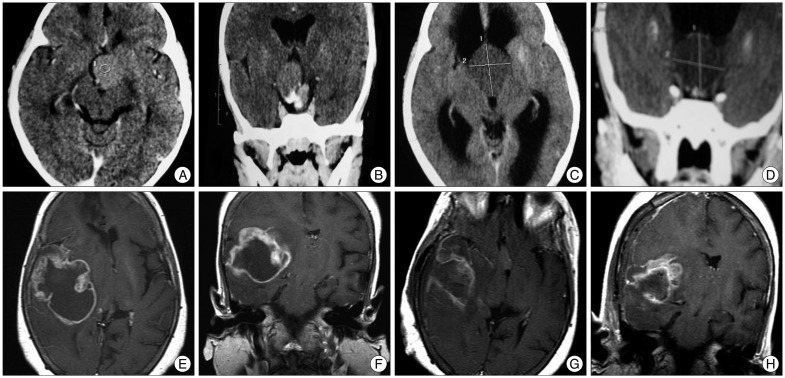J Korean Neurosurg Soc.
2014 Jan;55(1):54-56. 10.3340/jkns.2014.55.1.54.
Should Adjuvant Radiotherapy Be Recommended for Pediatric Craniopharyngiomas?
- Affiliations
-
- 1Department of Neurosurgery, Sri Satya Sai Institute of Higher Medical Sciences, Bangalore, India. ravi.dadlani@gmail.com
- 2Department of Pathology, Sri Satya Sai Institute of Higher Medical Sciences, Bangalore, India.
- KMID: 2191043
- DOI: http://doi.org/10.3340/jkns.2014.55.1.54
Abstract
- Intracranial tumors secondary to radiotherapy are rare. In this group gliomas are the rarest. Only 6 cases of glioblastoma multiforme (GBM) have been reported in patients undergoing radiotherapy (RT) for craniopharyngiomas of which only 4 have been in children less than 18 years of age. In recent years RT has become a mainstay of adjuvant therapy for recurrent or partially excised craniopharyngiomas. We report a child of 12 years who had previously undergone RT for a suprasellar craniopharyngioma and presented 10 years later with a GBM. This is the 5th pediatric case in literature demonstrating a GBM after RT for a craniopharyngioma. The implications of subjecting the pediatric population to RT for a benign lesion versus the outcome of gross total removal and management of RT induced tumors is discussed and the need to avail of safer alternatives such as stereotactic radiosurgery is stressed.
Keyword
MeSH Terms
Figure
Reference
-
1. Enchev Y, Ferdinandov D, Kounin G, Encheva E, Bussarsky V. Radiation-induced gliomas following radiotherapy for craniopharyngiomas : a case report and review of the literature. Clin Neurol Neurosurg. 2009; 111:591–596. PMID: 19447544.
Article2. Gleeson H, Amin R, Maghnie M. 'Do no harm' : management of craniopharyngioma. Eur J Endocrinol. 2008; 159(Suppl 1):S95–S99. PMID: 18775978.3. Kalapurakal JA. Radiation therapy in the management of pediatric craniopharyngiomas--a review. Childs Nerv Syst. 2005; 21:808–816. PMID: 16075214.
Article4. Kawamata T, Amano K, Aihara Y, Kubo O, Hori T. Optimal treatment strategy for craniopharyngiomas based on long-term functional outcomes of recent and past treatment modalities. Neurosurg Rev. 2010; 33:71–81. PMID: 19669813.
Article5. Kitanaka C, Shitara N, Nakagomi T, Nakamura H, Genka S, Nakagawa K, et al. Postradiation astrocytoma. Report of two cases. J Neurosurg. 1989; 70:469–474. PMID: 2536806.6. Monje ML, Ramakrishna NR, Young G, Drappatz J, Doherty LM, Wen PY, et al. Durable response of a radiation-induced, high-grade cerebellar glioma to temozolomide. J Neurooncol. 2007; 84:179–183. PMID: 17332945.
Article
- Full Text Links
- Actions
-
Cited
- CITED
-
- Close
- Share
- Similar articles
-
- Risk Factors of Recurrence after Gross Total Excision in Pediatric Craniopharyngioma
- Role of Adjuvant Radiotherapy in Gastric Cancer
- Radiotherapy for prostate cancer
- Effect of Adjuvant Hormonal Therapy on the Development of Pulmonary Fibrosis after Postoperative Radiotherapy for Breast Cancer
- Postoperative Adjuvant Radiotherapy for Patients with Gastric Adenocarcinoma



